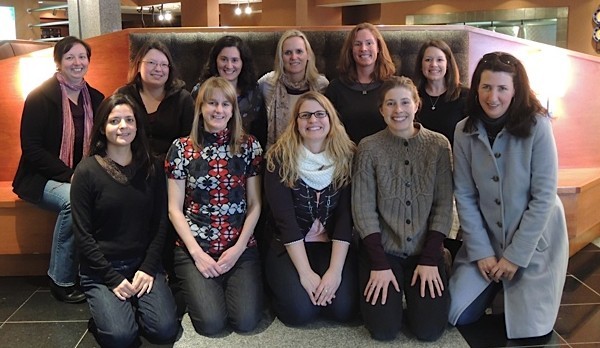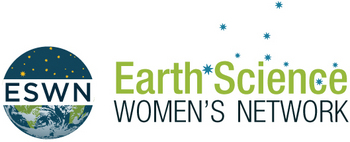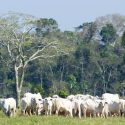New nonprofit supports women in science

The ESWN Leadership Board includes (front row) Carmen Rodriguez, Allison Steiner, Becca Barnes, Emily Fischer, Tracey Holloway, (back row) Meredith Hastings, Mirjam Glessmer, Erika Marín-Spiotta, Agatha de Boer, Christine Wiedinmyer, Manda Adams.
Photo courtesy of ESWN
Tracey Holloway was a postdoctoral researcher at Columbia University in 2002, Ph.D. from Princeton University freshly in hand, when she and five colleagues teamed up to create an informal support network for other women in their field.
“We wanted to provide an environment to connect with women at a similar level, to share experiences and share advice,” says Holloway, now a professor in the Nelson Institute for Environmental Studies at the University of Wisconsin–Madison.
Today, the Earth Science Women’s Network (ESWN) is a diverse group of more than 2,000 women across the globe, including 56 members from Wisconsin, and Holloway is proud to announce that the once-fledgling group has grown up to become a nonprofit organization.

“We have a lot of big ideas and a lot of little ideas and we can finally advance them all,” says Holloway, who is hopeful ESWN’s nonprofit status can help connect the group with supporters who “feel passionate about increasing diversity in science and helping early career scientists get established.”
UW-Madison has long supported Holloway as co-founder of the group: Nelson hosted events and an early website for the network and the UW–Madison 4W Initiative currently funds an undergraduate staff member, Colleen Schmit, to work with the leadership board and manage ESWN’s social media. The university is also one of the best-represented institutions in the network.
But as the organization has grown, its leaders — including co-founder Meredith Hastings, an assistant professor at Brown University; UW–Madison assistant professor of geography Erika Marín-Spiotta; and colleagues from institutions and organizations around the U.S. — have sought to make it more structured and formal.
In 2009, the group was awarded a $1 million National Science Foundation (NSF) grant to develop the network, which included the launch of its social media website. Once the grant ran out in 2013, Holloway and her co-leaders began contemplating ESWN’s next steps.
“I think women are facing different challenges: balancing family and work, navigating situations designed for men. The career trajectory was not intended for women trying to achieve other goals in life.”
Tracey Holloway
They wanted a structure that would allow them to continue ESWN’s online and in-person peer mentoring activities, and help them develop new initiatives to support women in the earth sciences at all career stages, such as providing travel grants to conferences, supporting efforts to overcome barriers to women’s success in science, and extending the outreach activities of the group.
“I think women are facing different challenges: balancing family and work, navigating situations designed for men,” says Holloway. “The career trajectory was not intended for women trying to achieve other goals in life.”
For instance, young scientists are expected to move several times as they progress from undergraduate student to graduate student, postdoc to early career scientist. These life transitions are a challenge for both men and women, but women face additional pressures. Women who want a family are often moving through their childbearing years, adding an extra layer of difficulty to an already daunting career path.
Additionally, a 2013 study of ESWN women and similar career-stage men found that, among scientists who lived with a partner, 59 percent of women were responsible for more or most of the household upkeep, versus 21 percent of men, and 50 percent of women handled the majority of parenting duties, compared to 9 percent of men.
Women also have to deal with the day-to-day issues associated with being underrepresented in engineering and science, like being the only female on a field research trip. According to a NSF report last year, less than a quarter of full-time, tenured professors are women, and men are more likely than women to receive federal research support.
Holloway is hopeful ESWN’s nonprofit status can help connect the group with supporters who “feel passionate about increasing diversity in science and helping early career scientists get established.
The network has helped women connect and support one another from across a broad range of earth science disciplines.
“ESWN is an incredible network of amazing role models. Whatever challenge you may be facing, someone in the group has successfully conquered it, and someone else can learn from your experiences,” says Marín-Spiotta.
The network has an eight-member leadership board, including Holloway and Marín-Spiotta. The group hosts regular networking events at major meetings, workshops for men and women at the annual meeting of the American Geophysical Union, and regional get-togethers and meetings at smaller conferences within various subdisciplines.
Earlier this year, ESWN launched a Tilt (formerly Crowdtilt) campaign to keep its website running once the NSF support expired. Members and other contributors nearly achieved their $14,000 goal.
With the help of a Madison-based lawyer, the group also embarked on the road to nonprofit formation this past spring.
“We want to expand the scope of ESWN, to better serve the needs of women building scientific careers, and girls considering a future in science,” says Holloway. “It has been inspiring to see how many lives and careers have been helped by ESWN. I want to carry that further.”



